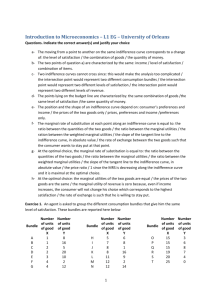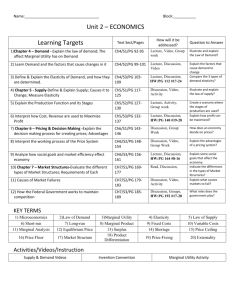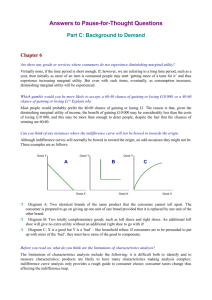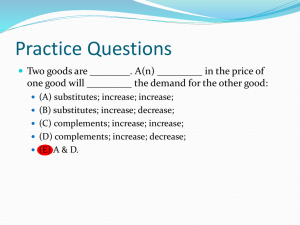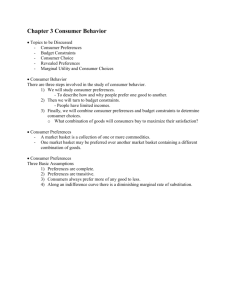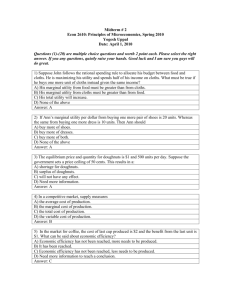ECON 203 Midterm Exam Solutions
advertisement
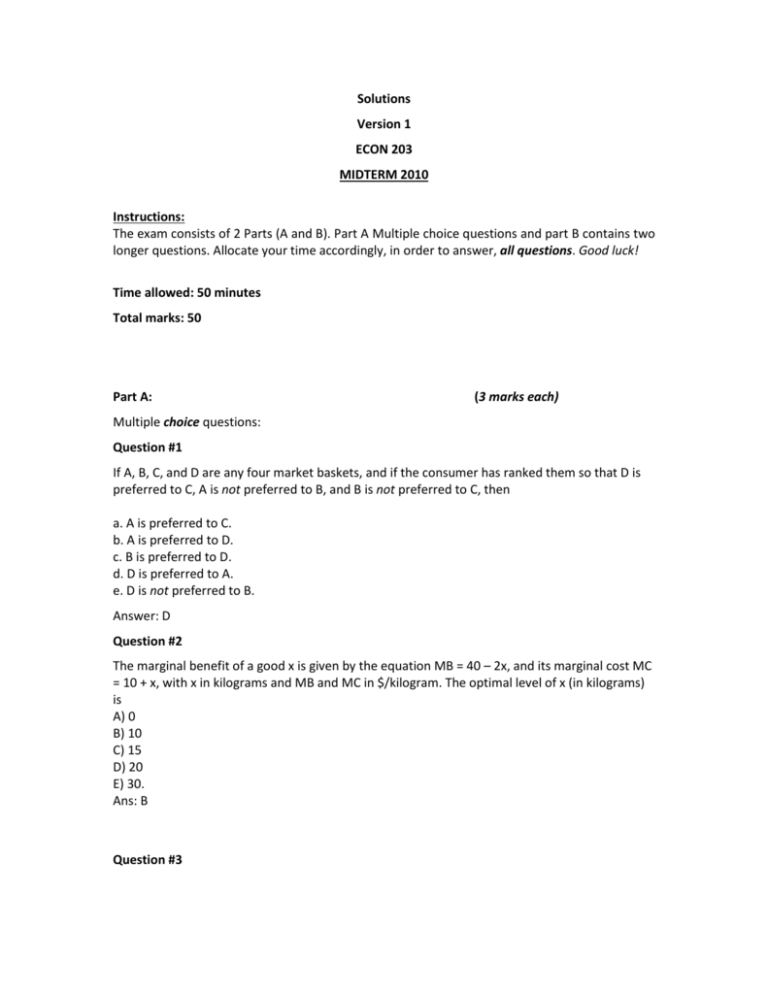
Solutions Version 1 ECON 203 MIDTERM 2010 Instructions: The exam consists of 2 Parts (A and B). Part A Multiple choice questions and part B contains two longer questions. Allocate your time accordingly, in order to answer, all questions. Good luck! Time allowed: 50 minutes Total marks: 50 Part A: (3 marks each) Multiple choice questions: Question #1 If A, B, C, and D are any four market baskets, and if the consumer has ranked them so that D is preferred to C, A is not preferred to B, and B is not preferred to C, then a. A is preferred to C. b. A is preferred to D. c. B is preferred to D. d. D is preferred to A. e. D is not preferred to B. Answer: D Question #2 The marginal benefit of a good x is given by the equation MB = 40 – 2x, and its marginal cost MC = 10 + x, with x in kilograms and MB and MC in $/kilogram. The optimal level of x (in kilograms) is A) 0 B) 10 C) 15 D) 20 E) 30. Ans: B Question #3 In 1976, a frost in Brazil killed over 500 million coffee trees and damaged many more. A civil war in Angola, a major supplier of coffee, cut back its crop. And, an earthquake in Guatemala disrupted the flow of coffee. In spite of these calamities, these three producers reported an increase in export earnings. On the basis of this information, which of the following must be true? a. The demand for coffee is price elastic. b. The supply of coffee is price elastic. c. The demand for coffee is price inelastic. d. The supply of coffee is price inelastic. e. The demand for coffee is unit elastic. Answer: c Question #4 Indifference curves that intersect would be illogical constructs because a. more is better than less. b. of diminishing marginal utility. c. of the transivity property of indifference theory. d. of both a and c above. e. of none of the above. Answer: d Question #5: Among all the combinations of goods attainable by a consumer, the one that maximizes total utility is the one that a. maximizes the marginal utilities per dollar of each good. b. maximizes the marginal utilities per pound (or other physical unit) of each good. c. equates the marginal utilities per dollar of each good. d. equates the marginal utilities per pound (or other physical unit) of each good. Answer: C Question #6: If a consumer’s marginal rate of substitution equals 2 eggs for 1 hamburger, a. the consumer’s indifference curve must be positively sloped. b. the consumer’s indifference curve must be convex with respect to the origin of the graph. c. the ratio of the consumer’s marginal utility of 1 egg to that of 1 hamburger must equal ½. d. all of the above are true. Answer:C Question #7: In spending all his or her income, the consumer chooses the market basket that maximizes his or her utility. Which of the following statements will be correct? 1. The marginal utility is the same for each commodity. 2. The marginal utility per dollar spent is the same for each commodity. 3. The marginal utility of each commodity is proportional to its price. a. 1 only. b. 2 only. c. 1 and 2 only. d. 2 and 3 only. e. 1, 2, and 3. Answer: D Question #8: If the demand curve for a good is downward sloping, then the good must be a. normal. b. inferior. c. Giffen. d. either (a) or (b). e. either (b) or (c). Answer: d Question #9: If the demand curve for a good is upward sloping, then which of the following statements must be true? 1. The good is inferior. 2. The substitution effect is in the opposite direction to the income effect. 3. The substitution effect overwhelms the income effect. a. 1 only. b. 2 only. c. 1 and 2 only. d. 2 and 3 only. e. 1, 2, and 3. Answer:C Question #10: The difference between a price decrease and an increase in income is that a. a price decrease does not affect the consumption of other goods while an increase in income does. b. an increase in income does not affect the slope of the budget line while a decrease in price does change the slope. c. a price decrease decreases real income while an increase in income increases real income. d.a price decrease leaves real income unchanged while an increase in income increases real income. Answer: B End of Part A Part B: 2 Longer Version Questions. (10 marks each) Question #1: Question: With food on the horizontal axis and train rides on the vertical axis, the price of train rides is $1/unit and the price of food is $10/unit. Initially Karl is consuming some of both goods at a point on his budget line where his MRS is 5. Is Karl maximizing his utility? How do you know? If Karl is not utility-maximizing, what should he do to improve his situation? Ans: Since the budget line (with slope = -10/1) is steeper than the indifference curve (with slope = 5), Karl is not maximizing his utility. Viewed graphically Karl's situation would appear as follows (with initial consumption at A): He should eat less food and take more train rides, as the higher indifference curve at E shows. Question #2: Use an appropriate diagram(s) to illustrate the decomposition of the total consumer response associated with a price decrease of an inferior good? Lecture 4 slide pg 50-58 End of Examination




